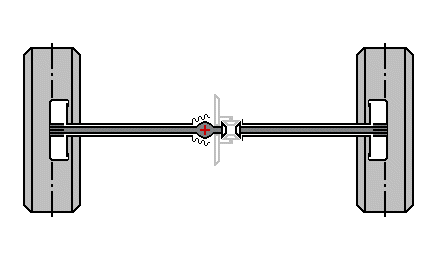
| Click on respective picture to see the reaction on compression and rebounding! |
Assignment
In the history of the suspension, the floating axle was the first step forward, from the rigid, driven axle, towards the modern independent suspension. Without this, or a more complicated construction, power to the drive-axle cannot be realised. It was built until about 1970, in isolated cases (e.g., the VW-Beetle, picture below) somewhat longer. In this construction the unsprung masses are distinctly lower than with the driven rigid axle. One can easily recognize vehicles with a floating axle, because when raising the vehicle, the rear wheels take on a positive camber.
Function
The differential gearbox is fastened onto the car-flooring. Near to the double-jointed swing axle (see picture above) there are two joints installed, these are lubricated by the rear axle oil and sealed with rubber sleeves. The axle shafts, together with the wheels, carry out a pendulum-like movement when the springs are compress or rebound.
Because there were no drive-shafts with a permanent gease filling like we have today, there were no joints on the wheels. As welcome as the pendulum movement is when compressing the springs, so disadvantageous is it when the springs rebound. The wheels take on a positive camber, which causes the vehicle to have a tendency to tilt to the side when cornering.
This effect is reduced by the single-joint swing axle (picture 1), e.g., in the Mercedes 190 (1956) up to the /8 (1968). In these models a tiltable differential is mounted to the coachwork. Thus, these vehicles need only one joint. In addition, the pendulum shafts are longer, which somewhat reduces the change in camber when the springs compress or rebound.
The tendency to positive camber can be further reduced, if the joint is placed as low as possible. At Mercedes this variation is partly combined with an additional coil-spring at the top between the two pendulum shafts. At this point, a practical, but not comfortable solution is the air springing, which is filled at the filling station and after discharging, is again bled off.
Mercedes still combined this variant with an additional coil spring on top between the two pendulums. A practical but unfortunately not comfortable solution is at this point the air spring, which is filled at the gas station and is vented again after unloading.